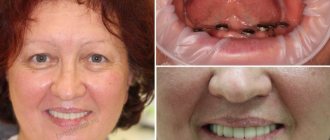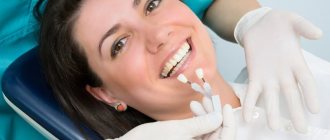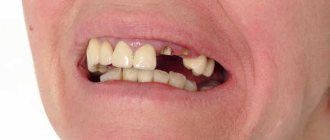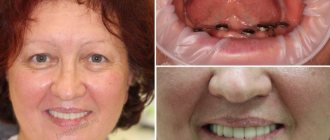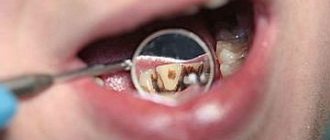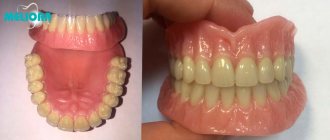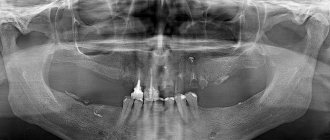In dentistry, complete or partial absence of teeth is called adentia. This pathology can be congenital (anomaly of the development of the dental system) or acquired. The disease is characterized by a violation of the continuity of the dentition. A person cannot chew, speak normally and experiences discomfort from a cosmetic defect in his smile. His diction and articulation are deteriorating, and his gastrointestinal tract is functioning worse.
Both complete and partial adentia are dangerous because, due to tooth loss, deformation of the facial skeleton and diseases of the temporomandibular joint (TMJ) are possible.
What is edentia in children?
Adentia in children is a partial or complete absence of teeth due to their loss or abnormal development of the dental system. The disease is characterized by impaired chewing and speech function due to the lack of integrity of the dentition. In severe cases, dental edentia in children is accompanied by deformation of the facial skeleton and further loss of teeth. In the complete absence of teeth, there is often a displacement of the lower jaw towards the nose, retraction of the soft tissues of the pre-oral area, and the formation of wrinkles. With partial edentia in children, the remaining teeth shift and diverge. And in the process of chewing, an increased load falls on them.
Interesting fact!
The rudiments of baby teeth are formed in babies still in the womb, at about 3-4 months of pregnancy. The process of their formation takes about a month, so it is important that during this period the expectant mother consumes dairy products rich in calcium, without which the full formation and subsequent health of teeth is impossible.
How to treat
Of course, living with such an illness is not easy. But there is only one treatment method - prosthetics. It is advisable to install orthopedic prostheses, removable or fixed, as early as possible. For primary adentia - as soon as the child reaches three years of age. In secondary cases, immediately after tooth loss.
By the way. If edentulousness is not treated, the consequences can be very serious. Not only the vital functions of the entire organism are disrupted, but also the psychological well-being of a person.
Consequences
This disease causes serious speech impairment (slurred pronunciation). Also, with edentia, due to the inability to perform biting and chewing functions, patients have to eat liquid or creamy soft foods. This cannot but affect the functioning of the digestive system, which is disrupted. It also reveals a lack of many nutrients that do not enter the body from food.
By the way. Due to the absence of teeth, problems with the temporomandibular joint arise. Its normal functioning is disrupted, which leads to various diseases.
In addition to medical problems, patients experience psychological difficulties. Social status decreases; he experiences psychological discomfort during communication and any communication. He often suffers from phobias, experiences stress, nervous system disorders, and is in a state of depression.
Prosthetic methods
In the treatment of this disease, various methods of prosthetics are used to return the patient to the functions that teeth should perform.
Table. Description of prosthetic methods for edentia
| Method | Description |
| It is possible to completely implant both dentitions, but only the wealthiest patients can decide on such an operation, due to its high cost. Therefore, usually as many teeth are implanted as necessary for further fixation of prosthetic structures on them. | |
| Installed on implanted implants. They are bridge-like structures that are firmly fixed to the implanted bases and cannot be removed. | |
| These are clasp and plate structures that are installed on the upper and lower jaw without the presence of supporting teeth. The patient can remove them independently. |
Important! When using prosthetics in young children diagnosed with congenital adentia of the first degree, there is a risk of stopping the growth of the jaw and its improper formation due to the fact that the prosthesis will put pressure on the jaw mechanism.
Types of edentia in children
Edentia in children is divided into types in accordance with the criteria indicated in the table below.
| Criterion | Type of edentia | Characteristic |
Time of occurrence | Primary (congenital) | Absence of baby teeth in young children and permanent teeth in older children |
| Secondary (acquired) | Lost tooth after eruption | |
Number of missing teeth | Partial | Some teeth are missing |
| Full | All teeth are missing | |
Age period | Edentia of temporary occlusion | Appears during the eruption of baby teeth |
| Edentia of permanent dentition | Appears during the period when baby teeth are replaced by permanent teeth. | |
Reason for missing tooth | True edentia | There is not even a tooth germ in the jaw |
| False edentia (retention) | Delayed tooth development. There is free space where the tooth should be, and subsequently it erupts |
Symptoms and development of partial edentia
A primary or secondary defect, called partial edentia, is characterized by the absence of not the entire dentition, but only some units. This disease can also be congenital or acquired during life. It occurs more often than the full form, and in dental practice it stands alongside other anomalies, such as hyperodontia (excess teeth) and hypodontia (fewer teeth than normal).
By the way. The primary partial form of the disease is diagnosed in 1% of pediatric patients, and the secondary form is diagnosed in 75% of patients over 60 years of age.
If complete loss of teeth is a real life catastrophe, then partial loss is not perceived in society as something threatening health and disrupting the normal course of life. Patients do not rush to the dentist to cure caries or get rid of chronic periodontal disease. As a result, they go to the surgeon and pull out the damaged teeth one by one.
Important! The absence of even a few teeth in the jaw for a long time leads not only to impaired aesthetics of the dentition, but is a prerequisite for pathological changes in the entire dental system, appearance, gastrointestinal tract, and psychological disorders.
Signs
The main symptom is a lack of teeth in a row or both rows. If this occurs over a long period of time, there are spaces between the teeth (empty spaces) that tend to be filled by growing teeth nearby. They gradually shift towards three, sometimes even closing there. There is a disruption in the development of the jaw, a change in the bite and facial relief.
The teeth that are in the mouth may be highly crowded, protrude from the dentition, grow on top of each other, and are often impacted (do not erupt from the gums).
Consequences
Since the teeth are constantly in motion (shifted to the side), increased stress is placed on them during the chewing process. There is no stress placed on the empty areas of missing teeth. As a result, destruction of the jaw bone is observed.
Important! The presence of three and incorrect placement of the remaining teeth in the row can cause local chronic gingivitis.
Complications may also occur in the form of:
- pathological abrasion of dental tissue;
- difficult and painful closing of the jaws;
- hyperesthesia;
- formation of bone pockets and voids in the gum tissue;
- dislocation of the jaw joint.
The shape of the facial oval changes and becomes deformed in the jaw area. Nasolabial folds are more pronounced. The corners of the mouth droop. Lips and cheeks “sink.”
People with partial edentia often have gastritis and ulcers due to nutritional problems that arise as a result of teeth not fully fulfilling their chewing purpose. And it is almost certain that a person who has lost several teeth will experience social discomfort and lower self-esteem.
Diagnosis of partial edentia
In diagnosing this disease, the experience and knowledge of a variety of specialists in the field of dentistry is used: orthodontists and therapists, orthopedists and surgeons, periodontists and implantologists. Here, a visual examination is not enough, as is the case with the full form of the disease, so radiography, computed tomography, and orthopantomography are performed.
An X-ray will not only reveal missing teeth, but also detect the absence of their rudiments, and will also show the roots that are located in the gum tissue, unerupted (impacted) teeth, tumors and inflammation.
Causes of edentia in children
Edentia in children can be hereditary, but it can also develop during the child’s life. In this regard, there are several causes of dental edentia in children.
- Absence or death of tooth buds.
This may be due to hereditary reasons, as well as disturbances in the formation of the fetus in the womb. A child’s dental plate is formed during the prenatal period, and exposure to harmful factors (for example, poor environment or an unhealthy lifestyle of the mother) can negatively affect this process. - Loss of teeth during life.
Children, especially boys, due to their activity, are more susceptible to injury than adults. Thus, children’s teeth often fall out during fights, falls, and also when playing certain sports (hockey, football, boxing). - Deep caries and its complications.
Due to the thin enamel of baby teeth, caries in children develops on them much faster than on permanent ones. Therefore, if it is not treated in a timely manner, there is a risk of losing the tooth as a result of progressive purulent-inflammatory processes in the tissues.
Edentia of the upper jaw
The upper jaw is more often than the lower jaw and is subject to various types of anomalies. As a rule, patients have symmetrical hypodentia of two teeth. And since the front teeth are involved in sound production and form the purity of pronunciation, this type of deformation is the most noticeable. The patient's speech becomes lisping and slurred, the smile “creeps away”, and saliva splashes.
Edentia of the lower jaw
The lower jaw has a small prosthetic bed, so when edentulous, the tongue begins to take the place of the lower teeth. As a result, the patient’s diction changes significantly and his well-being worsens.
Treatment of adentia in children
Diagnosis of dental adentia in children is carried out by visual and palpation examination, targeted intraoral radiography and orthopantomography. The treatment tactics for adentia in children are determined taking into account the physiological, anatomical and hygienic characteristics of the child’s dental system. Depending on the degree of the disease, the following methods of treating adentia in children are used.
- Stimulation of teething.
In some cases, a procedure is used to dissect the gums and install special braces that stimulate teething.
- Fixed prosthetics.
The child is fitted with permanent orthopedic structures (crowns, bridges).
- Removable prosthetics.
Removable orthopedic structures (clasp, plate dentures) are installed.
- Dental implantation.
It is used only after the jaw bones are completely formed. This process is usually completed at the age of 18 for boys and at 16-17 years for girls. Until this time, edentulous treatment is carried out using removable and fixed dentures.
Diagnosis and treatment
To diagnose the disease, the dentist needs a detailed examination of the patient’s oral cavity. The doctor asks the patient a number of things:
- causes and timing of tooth loss;
- information about previous diseases;
- data on dental prostheses previously used by the patient.
During the examination, the dentist notes the asymmetry of the face, the severity of the chin and nasolabial folds, the degree of reduction in the height of the lower part of the face, the presence of a jam, the nature of the closure of the lips, the topography of the transitional fold, the degree of mouth opening, the nature of the jaw relationship. The specialist also determines the presence of crunching in the joints, pain when moving the lower jaw and diagnoses the degree of atrophy of the alveolar processes.
The examination necessarily includes palpation of the oral cavity and radiography of the TMJ. Based on the data obtained, the doctor determines further treatment tactics (prosthetics), selects the appropriate type of prosthesis and impression material for the patient.
Consequences of edentia in children
If you do not consult a specialist in time and do not treat edentia in children, this can lead to deformation of the facial skeleton, which results in developmental defects in the child.
- Speech impairment.
With complete or partial absence of teeth, the child pronounces some sounds incorrectly, and may even lose the ability to pronounce them. - Chewing dysfunction.
Due to a decrease in the quality of chewing food and changes in food consumption patterns, missing teeth often leads to gastrointestinal diseases in a child. - Mental disorders.
Missing teeth is also a cosmetic defect. The baby is embarrassed to smile, and as a result he develops complexes. In addition, disturbances in the functioning of the jaws caused by edentia bring discomfort and cause deterioration in mood.
Prevention of edentia
As for the congenital form of the disease, preventive measures to ensure that the child is born with normally formed tooth buds should be taken by his mother during pregnancy.
- Ensuring a favorable course of pregnancy.
- Creating conditions for intrauterine development.
- Elimination of all, even potential risks.
If a newborn child experiences a long delay, which is six months or more longer than the required time for teething, you should contact a pediatric dentist.
Partial acquired adentia can be prevented by timely contacting a dentist and eliminating any dental problems that have arisen. It is also necessary to observe hygienic measures for caring for the oral cavity.
In case of tooth loss or extraction, it is necessary to carry out prosthetics as soon as possible to restore the dentition and to avoid the development of adentia. The root of the tooth hurts, study the link.
How much does treatment cost?
Treatment of adentia in children begins with an initial examination and drawing up a treatment plan. Typically, these services are provided free of charge - as a promotion to attract customers. Also, a small patient will need to have an x-ray at a cost of 350 rubles and a panoramic photograph of the oral cavity, the cost of which starts at 1,000 rubles. In addition, before starting treatment of adentia in children, it is necessary to carry out professional oral hygiene at a price of 2,700 rubles and more. Based on the fact that edentia in children is treated primarily by installing removable dentures, parents should be prepared for the following costs for various types of orthopedic structures: a partially removable laminar denture costs from 1,750 to 60,000 rubles, a complete removable laminar denture costs from 40,000 to 100,000 rubles, temporary complete removable denture - from 2,800 to 3,500 rubles. A removable acrylic prosthesis will cost from 12,000 rubles, a bridge prosthesis - from 25,000 rubles. The cost usually includes the manufacture of the structure and its installation by a specialist.
Lack of teeth in humans: what is it and what does it mean?
What is jaw edentia? If in some species of animals the dentition is renewed continuously or at least repeatedly (for example, in Indian elephants), then people have only two sets of teeth - milk and molars. Unfortunately, they can be lost during life, and with some types of anomalies and diseases, a person initially lacks one, several or even all tooth germs. Adentia is a situation where there is a lack of teeth on one or both jaws. In this case, the absence of eights is not taken into account, since they are a rudiment and may not appear in principle. Experts highlight the absence of primary and molar teeth. In the latter case, the loss is irreparable. Therefore, most often they talk about edentulous molars, taking into account the fact that all the most negative consequences of this disease are especially pronounced in adulthood.
What does missing teeth affect?
- Chewing dysfunction.
- Problems with the digestive system.
- Deterioration of aesthetics. The most noticeable consequence of edentia. A diagnosis of “missing teeth” is often a death sentence for a beautiful smile.
- Bone tissue atrophy. Without the load that the teeth bear, the bone tissue begins to dissolve. When there is a lack of teeth, over time the face seems to shrink in the lower part and those same senile sunken cheeks appear. This is a consequence of bone atrophy.
- Curvature of teeth. In the absence of teeth, the bite is disrupted and the dentition shifts. It also distorts a person's facial features.
- Problems with diction.
Unlike many dental diseases, signs of missing molars (as well as milk teeth) are very obvious. Diagnosis of edentia is usually carried out visually. However, to assess the condition of the bone tissue and the entire dentofacial apparatus as a whole, an x-ray examination is necessary. Now that it has become clear what jaw edentia is, it is necessary to talk about the causes and types of the disease.
Complications
Adentia entails disturbances of an anatomical and aesthetic nature:
- in the place of missing units, the toothless bone structure of the jaw becomes thinner over time;
- the symmetry of the face and the connection of the lips are disturbed, facial folds on the chin and in the nasolabial area deepen, the corners of the mouth droop;
- non-anatomical development of the jaws. It is more pronounced when there are a large number of missing units;
- with a numerous shortage of units at the LF, it begins to protrude forward and form a deep bite, moving into the HF.
Anatomical underdevelopment of the jaw bones does not always occur, and in children and adults it manifests itself differently. However, with all types of anomalies, negative clinical manifestations occur.
Important characteristics of complete or numerous adentia are the formation of a pathological bite and disruption of the digestive system. The bolus of food is difficult to chew, and the person has to limit his or her food intake. This pathology reduces self-esteem and makes you feel uncomfortable.
Symptoms of edentia
The main symptom of edentulism is the patient’s lack of teeth. The clinical picture of the disease can be supplemented by:
- pronounced reduction of both jaws;
- retraction of soft tissues in the oral area;
- the appearance of blunt exostoses or painful sharp bone protrusions on the jaws;
- formation of wrinkles in the perioral area;
- atrophy and laxity of the muscles of the lower lobe of the face;
- serious disorders of speech functions (the patient loses the ability to clearly and clearly pronounce dental-linguistic sounds - “ch”, “n”, “z”, “l”, “t”, “d”);
- lack of function to bite off and fully chew food;
- disturbances in the functioning of the TMJ (temporomandibular joint);
- disruptions in the gastrointestinal tract.
The development of adentia is one of the factors that significantly reduces the patient’s self-esteem, causing him to experience constant psychological and physical discomfort.
Causes (etiology)
The fundamental cause of adentia is the absence or unformation of tooth buds. In the primary condition, the pathogenesis may be inherited or due to detrimental effects during the construction of the fetal dental plate.
Complete adentia from birth in children is a fairly rare manifestation that occurs due to ectodermal dysplasia. The general state of health is complicated by: incomplete development of hair structures, layers of the epidermis, nail plates, excretory glands, eye lenses, and the central nervous system.
Other known reasons include:
- lack of minerals and vitamins in the intrauterine development of the fetus, resulting from illnesses of the mother during pregnancy;
- childhood diseases;
- genetics;
- pathology of the thyroid gland;
- disruption of the formation of the outer layer of the embryo;
- taking medications for the treatment of concomitant diseases (antibiotics, chemotherapy);
- inflammatory purulent processes in the jaws.
The origin of secondary loss of units can be complicated by caries, trauma, phlegmon and abscesses, poor-quality treatment and prosthetics.
How tooth loss affects facial contours
Loss of teeth, especially complete ones, immediately affects a person’s appearance. Firstly, the height of the lower third of the face decreases due to the fact that the support of the lower jaw by the teeth is lost and the jaw moves back in the joint area, and forward and upward in the chin area.
The result is a so-called “senile face” - the distance between the tip of the nose and the top of the chin decreases. Due to this, the natural folds of the face deepen, the corners of the mouth droop, the red border of the lips decreases in width due to their displacement towards the oral cavity.
Losing teeth causes a decrease in the tone of facial muscles, the cheeks and chin tissues sag. Visually, the face looks more mature. Dental restoration sets the lower jaw in the correct position, provides support to soft tissues, and restores the smile. As a result, facial rejuvenation occurs, patients feel confident, and their quality of life improves significantly.
These changes are also possible with partial loss of teeth.
Especially in the case of chewing teeth. I have patients (women) who turned to a cosmetologist with a desire to improve their facial contours and eliminate sagging cheeks. In response to this, the doctor strongly recommends that the missing chewing teeth be restored first to provide soft tissue support and only then begins his own procedures. Because only in this case we get the most complete and long-lasting effect.
Primary and secondary edentulous teeth
Experts distinguish several types and subtypes of adentia. For greater convenience, below are tables showing the types of the disease, combined by certain characteristics.
Primary adentia
Caused by hereditary factors and diseases at the stage of fetal formation. With primary adentia, there is an absence of tooth germs.
Varies:
- partial primary adentia - the absence of one or more rudiments (for example, primary adentia of two incisors);
- complete primary adentia – absence of all tooth buds. It is extremely rare;
- true adentia – absence of tooth buds (without their destruction by diseases and infections);
- false edentia, when different teeth merge into one.
Secondary adentia
Secondary adentia occurs as a result of illness and injury during life.
Classification of missing teeth according to the location of the disease
| By localization | Description |
| Missing upper teeth | The absence of teeth in the upper jaw can be either partial or complete, as well as single. |
| Missing lower teeth | A general designation for a disease indicating the absence of teeth in the lower jaw. |
| Lack of chewing teeth | May be referred to as missing lateral teeth. Lack or complete edentulism in the chewing region. In particular, we are talking about the absence of small molars (premolars) and molars. |
| Missing front teeth | Edentia of incisors or canines in the frontal zone. |
In addition to the classification described above, the type of teeth itself is also taken into account. Based on this, the absence of molars and edentulous primary teeth (not associated with the normal timing of their replacement) are distinguished.

